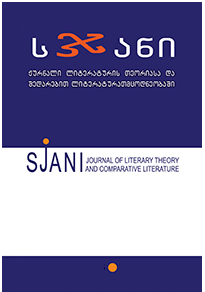ანდაზისა და სიტყვის მასალის კონტექსტური კვლევის ზოგიერთი საკითხი
Main Article Content
ანოტაცია
In oral histories important place is occupied by folklore genres such as legends, oral traditions, proverbs, aphorisms, traditional sayings, anecdotes, explanations, charms and so on-that are very popular among contemporary population who reveal great interest to them up today. During the research of the proverbs and traditional sayings we confront with certain problems as their allegorical meaning is not connected to a certain fact, accordingly for making sense of them it is necessary to investigate them in the context. Such opportunity was given in the oral histories. The topic of investigation of proverbs and traditional sayings became our aim during fieldwork when we discovered that population used it wide scale, especially aged people. Later when we started the study of the theoretical material on this topic we discovered that the problem was brought forward still in 1957 by folklorist Pikria Zandukeli. She marked that during fieldwork in Upper Imereti she could not find a narrator who managed to make a list of proverbs alike samples of other genres, though she had a chance to collect them when the narrator used them during narration for strengthening the facts throughout story telling. Hence it is clear that people used proverbs and traditional sayings for confirming and turning stronger their opinion in the context (Zandukeli 1964: 148-149). If we look through the history of inestigation of proverbs we can discover diversity of researches. In 1953 prof. M. Chikovani in old Georgian literature discovered that the word “Proverb” was used in the meaning of “a short story” too. Parnaoz Ertelishvili took attention to the figurative meaning of proverbs
(1957). On the problem of proverb a broad investigation was made by prof. Ksenia sikharulidze (1960).
In the Vth volume of the “Folk Wisdom” published in 1964 scientist L. Lejhava divided proverbs into 8 groups: 1. Simple proverbs; 2. Proverbial expressions; 3 Aphorisms; 4. Proverbs; 5. Parables; 6. Proverbial sayings; 7. Blessing and cursing formulae; 8. Separate strophes from folk poetry.
Presented investigation gives the contextual analysis of proverbs and traditional sayings. Why these two? We think that it is difficult to mark out the boundaries of them as sometimes one part of a proverb is spread independently and is transformed into traditional saying. A proverb is a simple, one-sentence saying expressing perceived truth based on common sense or experience. If we run over the history of the topic we will have various pictures. That was the object of investigation of many scientists. Publication of proverbs started in XIX century. The first publication of proverbs is dated to 1846 in “Chrestomathy of Georgian Literature” by D. Chubinashvili. In 1876 P. Umikashvili published the collection of the Georgian proverbs. Presented investigation is based on the following academic publications: Folk Wisdom IV and Folk Literature II by P. Umikashvili. The texts for the comparative analysis were
compared to the published materials and unpublished ones kept in the Data Base http://www.folktreasury.ge/ARPA/. Materials of the oral history were used from the collection of “Millennium in Interior” (2011) and video recordings of the folklore expedition (2009) kept in the Folklore Archive of Shota Rustaveli Institute of Georgian Literature (Cipher FA1K1). The investigation includes published interviews, too. For the quantity of the material it was not possible to present the whole data, though wide chapter will be published in the doctoral dissertation. As we see the material recorded from the oral histories is significant from the point of view of observing the proverbs in the context, the method of investigation is novelty. We don’t share the opinion that a proverb has a petrified form, investigating them in the oral histories we see that they are varied. Traditional sayings are part of them and are often called witticisms. In her investigation “On the Relationship Between Proverbs and Traditional Sayings” Pikria Zandukeli considers that a proverb is a complete sentence and the traditional saying is its part. Other difference between them is that a proverb is multinumbered logically, while a traditional saying is one-numbered. The third difference is followingtraditional saying is lacking complete skill of discussion. Investigation revealed that proverb and traditional saying is widely used in conversation for turning stronger and firmer a certain idea, opinion (Zandukeli 1964).
Folklorist G. Chelidze took attention to the specific feautures of proverbs: laconicism, expressiveness and one planess. Scientist T. Kurdovanidze marked out oppositional pairs in proverbs. Scientist L. Bregadze studied the Georgian proverbs published in 1881-1913 and dedicated a broad research to them.
Respodents talking on social, cultural, traditional, religious and philosophical topics used correctly corresponding proverbs and traditional sayings. There was also revealed variational diversity. Thus the material under investigation showed that proverbs and traditional sayings are closely connected to the way of life up today not losing topicality.
